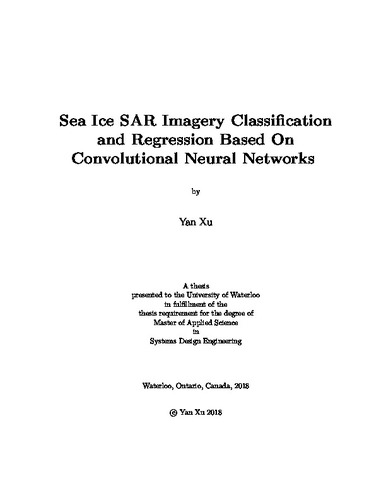| dc.contributor.author | Xu, Yan | |
| dc.date.accessioned | 2018-08-01 12:55:52 (GMT) | |
| dc.date.available | 2018-08-01 12:55:52 (GMT) | |
| dc.date.issued | 2018-08-01 | |
| dc.date.submitted | 2018-07-26 | |
| dc.identifier.uri | http://hdl.handle.net/10012/13506 | |
| dc.description.abstract | Due to the global warming, there have been signficant reductions in the ice extent and ice thickness in the Arctic and marginal seas. Monitoring these changes in sea ice is very important for human activities including weather forecasting, natural-resource extraction, and ship navigation.
Of the various sea ice monitoring activities, and sea ice and open water classification, sea ice concentration estimation has attracted significant attention due to the importance of this type of information. Satellite imagery is widely used for monitoring the ice cover. In this regard, images from synthetic aperture radar (SAR) are of interest due to their high spatial resolution. However, automated SAR imagery interpretation is a complex recognition task that requires algorithms with strong ability to learn complex features.
Convolutional neural networks (CNNs) are the state-of-the-art in the image recognition field and CNNs have demonstrated an excellent ability to learn complicated image features. In this thesis, we first used a CNN-based transfer learning method to address sea ice and water classification challenge, which achieves an impressive classification accuracy (92.36%). Then sea ice concentration estimation from SAR image using CNNs is developed. The CNN models are trained from scratch using image analysis charts as ground truth.
Based on the designed CNN, several studies are conducted. We first demonstrate the importance of including samples of intermediate ice concentration in our training data. Then experiments are carried out to increase the number of these samples in our dataset. The results from experiments indicate that model performance can be improved by adding more intermediate ice concentration samples from new datasets, regardless of the location, time, and sea ice features of new datasets. Another benefit of balancing the dataset is that the estimation results of intermediate ice concentrations from the CNN become more accurate. In addition, the CNN model we adopted is found to outperform other algorithms on distinguishing the marginal ice zone. | en |
| dc.language.iso | en | en |
| dc.publisher | University of Waterloo | en |
| dc.subject | Sea Ice | en |
| dc.subject | Convolutional Neural Networks | en |
| dc.subject | SAR Imagery | en |
| dc.title | Sea Ice SAR Imagery Classification and Regression Based On Convolutional Neural Networks | en |
| dc.type | Master Thesis | en |
| dc.pending | false | |
| uws-etd.degree.department | Systems Design Engineering | en |
| uws-etd.degree.discipline | System Design Engineering | en |
| uws-etd.degree.grantor | University of Waterloo | en |
| uws-etd.degree | Master of Applied Science | en |
| uws.contributor.advisor | Scott, Andrea | |
| uws.contributor.affiliation1 | Faculty of Engineering | en |
| uws.published.city | Waterloo | en |
| uws.published.country | Canada | en |
| uws.published.province | Ontario | en |
| uws.typeOfResource | Text | en |
| uws.peerReviewStatus | Unreviewed | en |
| uws.scholarLevel | Graduate | en |

